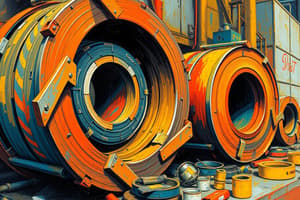Podcast
Questions and Answers
What is the primary difference between weather and climate?
What is the primary difference between weather and climate?
- Weather results from interactions of atmosphere, oceans, and land while climate is determined by solar radiation.
- Climate is influenced by latitude while weather is influenced by solar radiation.
- Climate is cyclical in nature while weather is more constant.
- Weather is short-term while climate is long-term. (correct)
How are ice ages primarily associated with changes on Earth?
How are ice ages primarily associated with changes on Earth?
- Shifts in the Earth's magnetic field.
- Changes in the Earth's orbit and the tilt of its axis. (correct)
- Variations in the structure of the atmosphere.
- Changes in ocean currents.
Which gases in the atmosphere have a direct influence on climate?
Which gases in the atmosphere have a direct influence on climate?
- Sulfur dioxide and nitrogen oxides.
- Nitrogen and oxygen.
- Trace gases like argon and neon.
- Carbon dioxide, methane, and water vapor. (correct)
How do latitude and altitude influence weather and climate?
How do latitude and altitude influence weather and climate?
What process regulates the composition and temperature of Earth's atmosphere?
What process regulates the composition and temperature of Earth's atmosphere?
How do ice ages impact large portions of Earth's land masses?
How do ice ages impact large portions of Earth's land masses?
Which of the following best describes the recycling process?
Which of the following best describes the recycling process?
What is the primary function of the nucleus in an atom?
What is the primary function of the nucleus in an atom?
How do electrons behave around the nucleus of an atom?
How do electrons behave around the nucleus of an atom?
What is the consequence of neglecting recycling processes for the environment?
What is the consequence of neglecting recycling processes for the environment?
Which statement best describes the relationship between atoms' composition and their properties?
Which statement best describes the relationship between atoms' composition and their properties?
What role do materials like paper, plastic, metals, and glass play in the recycling process?
What role do materials like paper, plastic, metals, and glass play in the recycling process?
Flashcards are hidden until you start studying
Study Notes
Materials and Cycles on Earth: Understanding Recycling, Atoms, Weather, Climate, and the Atmosphere
Our planet is a dynamic web of interconnected processes that continuously shape and reshape the Earth. In this article, we'll delve into some fundamental aspects of these processes, from the structure of the atom to climate phenomena, with a particular focus on how materials and cycles relate to each of these topics.
Recycling Processes
Recycling is the process of collecting and reusing materials that would otherwise have been discarded as waste. This practice helps conserve resources, reduce energy consumption, and minimize pollution associated with extracting raw materials and manufacturing new products. The materials we recycle include paper, plastic, metals, glass, and electronics, and the process can be mechanical, chemical, or a combination of both.
The Structure of the Atom
To understand recycling and other geological and environmental processes, it's essential to appreciate the structure of the atom. The atom consists of a positively charged nucleus containing protons and neutrons, surrounded by negatively charged electrons. These electrons orbit the nucleus in discrete energy levels called shells. The elements in our world are composed of different combinations of protons, neutrons, and electrons, resulting in distinct properties and behaviors.
Weather and Climate
Weather refers to short-term atmospheric conditions, such as temperature, humidity, and wind, while climate refers to long-term patterns of weather. Weather results from the interaction of the atmosphere, oceans, and land, and it's influenced by factors like solar radiation, latitude, altitude, and ocean currents. Climate, on the other hand, is determined by long-term averages of weather elements and their typical variations.
Climate and Ice Ages
Ice ages are long-term, cyclical periods of glaciation and warming, with global temperatures dropping and rising over thousands of years. They are primarily associated with changes in the Earth's orbit and the tilt of its axis. During ice ages, large portions of Earth's land masses are covered by glaciers, affecting climate, global sea levels, and ecosystems. The most recent ice age, the Quaternary glaciation, began about 2.6 million years ago and is still ongoing.
Atmosphere and Climate
The atmosphere is a thin layer of gases that surrounds the Earth and is essential for sustaining life. Its composition is predominantly nitrogen and oxygen, but it also contains trace gases like carbon dioxide, methane, and water vapor which directly and indirectly influence climate. The atmosphere's composition and temperature are regulated by processes such as photosynthesis, respiration, evaporation, and the greenhouse effect.
Throughout history, materials and cycles have interacted in various ways to shape our planet. The study of these interactions provides valuable insights into Earth's past, present, and future, and underscores the importance of sustainable practices for our planet's well-being.
Studying That Suits You
Use AI to generate personalized quizzes and flashcards to suit your learning preferences.



